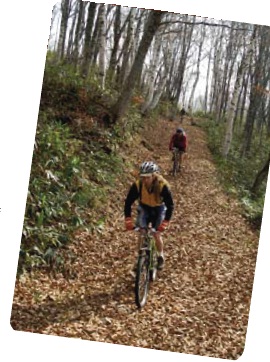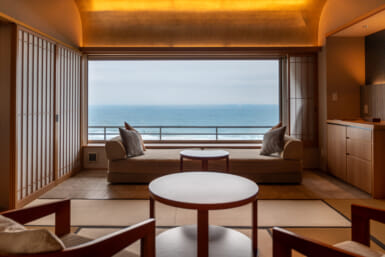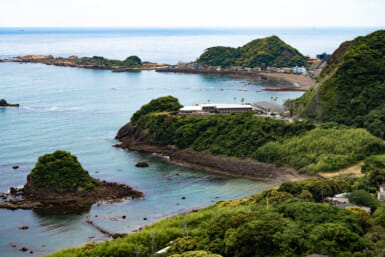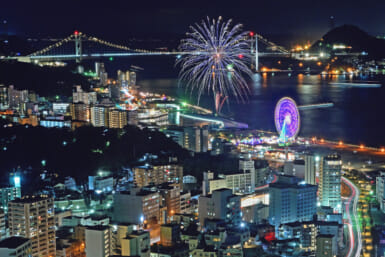Getting back to the outdoor
by David Enright
Another Japanese summer is coming to a close and a refreshing autumn breeze is in the air. Soon the landscape will start to glow with the autumn colors of the deciduous forests that cloak the mountains of the Japanese Alps. This is the season to do all those activities that the hot summer swelter, and the crowds prevented you from doing in reasonable comfort. Activities such as biking, hiking, climbing, canoeing, and paragliding are among the favorites at this time of year.
Japan is a great place to pack up your saddlebags and hop on your bike for some great touring of the countryside. It is not hard to find small country roads that allow you to travel without the worry of large trucks and fast cars. The pace is slower in the country, people stop and greet each other and make prayers at the multiple road side shrines and the ojizo-sama (stone gods that are seens often wearing little bibs) as they go about their daily chores. The villages that you pass through along these roads will look and feel a million miles away from the urban sprawl of Tokyo and will no doubt be a refreshing change from the norm. There are also, of course, some great dirt roads and single track courses along the way and recently in more recreational centers, one can find raised platform trails and dirt jump tracks that mountain bike enthusi¬asts can ride to their hearts content.
Scenic
Those looking for an even slower-paced adventure may want to take to the hills and explore the Japanese Alps during the autumn change of colors; the ever revered Japanese koyo (leaves changing in autumn). There are a multitude of great trekking routes with spectacular peaks to discover, with all the amenities, along your journey. Many people have a desire to climb the symbol of Japan, Fuji-san, but if you are looking for beauti¬ful scenery, solitude, wildlife andnot to mention much more interesting trails to travel along, then please look to the Japanese Alps and you will be assured of a marvelous experience. There are most often high-road passes and gondola assisted approaches for easy access to alpine ridges that can get you to some spectacular craggy peaks and back in one day. Alteranatrvly, you may want to travel the highlands of Japan for a week or two without ever having to come down into town.
As the topography of Japan is mostly mountainous there are also many great spots for climbing and more advanced mountaineering from the small seaside crags to the high alpine routes in the Japanese Alps of Nagano, Yamanashi, and Gunma. Searching out one of the many professional climbing or mountain guides in the area that you wish to explore might be in your best interest to get an insight to the areas that suit your ability and endurance.
Flying high
The Gondola accessed ski resorts also provide an arena for paragliding in the non-ski season and allows those seeking a bit more of a thrill a chance at flying high above the valley floor. Even those who have never flown before can experience the exhilaration of flight by riding tandemwith professional pilots and soaring on the wind. The ride, after the initial elation of not having your feet firmly planted on terra firma, is quite relaxing and allows you lots of time to admire the view of the mountains at eye level, rather than looking up from below at the 3,000 meter peaks.
At the base of these towering peaks are innumerable crystal clear creaks and rivers fed by natural springs and snowmelt, flowing into and from lakes that are clear and pristine. Not only are there cool water springs, but hot springs abound in the Northern Japanese Alps and a trip to the mountains would not be complete with out a soothing soak in a Japanese onsen.
Along the banks of these fast flowing rivers and clear lakes there are multiple fishing holes and campsites, as well as great locations with dramatic views into the Japanese Alps for barbeques or picnics. These rivers and lakes with spectacular views make for superb canoeing during October as the fall colors viewed from the lake are awe-inspiring. Lake Aokiko, ‘Blue Tree Lake,’ is one of those very special places within Japan and is noted as being Japan’s third clearest lake. There are no powerboats allowed on the lake, which makes Aokiko a very relaxing and enjoyable place to take it slow and easy.
So this fall, think about taking it slow and easy while enjoying the colorful Japanese Alps and the great outdoors on your favorite form of transport!
Dave is the owner and director of the Evergreen Outdoor Center based out of Hakuba, Nagano. he has been instrumental in developing outdoor activities, ecological tours, and mountain safety courses in the Nagano region for over a decade. For more information, see www.evergreen-hakuba.com or call 0261-72-5150.









